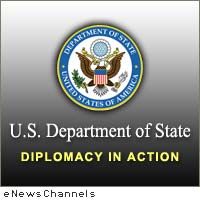 WASHINGTON, D.C. /eNewsChannels/ — In response to the spike in global food prices in 2007-2008, President Obama pledged $3.5 billion to help poor countries fight hunger by investing in agricultural development. The U.S. Government’s Feed the Future Initiative utilizes innovation, research, and development to improve agricultural productivity, link farmers to local and regional markets, enhance nutrition, and build safety nets.
WASHINGTON, D.C. /eNewsChannels/ — In response to the spike in global food prices in 2007-2008, President Obama pledged $3.5 billion to help poor countries fight hunger by investing in agricultural development. The U.S. Government’s Feed the Future Initiative utilizes innovation, research, and development to improve agricultural productivity, link farmers to local and regional markets, enhance nutrition, and build safety nets.
These investments will increase the supply of food where it is needed and help vulnerable people withstand price shocks better.
* The United States will continue to provide food aid during times of crisis, but a lasting solution to hunger requires a long-term commitment to agricultural growth.
* Agricultural growth fosters economic growth, reduces poverty, improves health, and is necessary to meet the needs of a growing world population in the face of climate change and other environmental challenges.
* The U.S. Government’s Feed the Future Initiative addresses the root causes of hunger that limit the potential of millions of people, using a combination of bilateral programs and multilateral mechanisms.
* Feed the Future promotes growth in the agriculture sector, facilitates local and regional trade, and invests in game-changing innovations and technologies to support productivity increases, so that countries are better able to combat hunger, feed their people, and contribute to stable global food supplies.
* An important component of Feed the Future is the Global Agriculture and Food Security Program (GAFSP). This multilateral trust fund has mobilized commitments nearing $1 billion from seven development partners to finance food security strategies in the world’s poorest countries. In 2010, GAFSP awarded $337 million in grants to eight countries, financing projects that enhance rural infrastructure, access to improved seeds and fertilizer, and better water management.
* Recently, USAID announced support for the World Economic Forum’s new agricultural framework – “Realizing a New Vision for Agriculture” – that also has the support of 17 global firms. It seeks to encourage private sector investments that boost agricultural growth, as well as enhance global food and nutrition initiatives.
* The United States works through multilateral and bi-lateral fora with stakeholders from civil society, the private sector, and governments to strengthen and support country-led initiatives. Examples of these efforts follow.
o In Tanzania, Feed the Future investments will improve rural community links to markets by improving roads. This will increase agricultural and other rural-based production, improve rural communities’ access to reasonably priced food, and stimulate greater off-farm employment opportunities.
o In Rwanda, where over 90 percent of households practice some form of farming, USAID is partnering with the World Food Program to develop new market opportunities for maize and bean producers. The Feed the Future initiative will support improvements in post-harvest handling to reduce losses, and the World Food Program will purchase these commodities from farmer cooperatives for use as food aid.
o Feed the Future investments will help Bangladesh cope with the impacts of climate change by investing in new technologies to improve rice production. Rice is the primary staple crop in Bangladesh.



